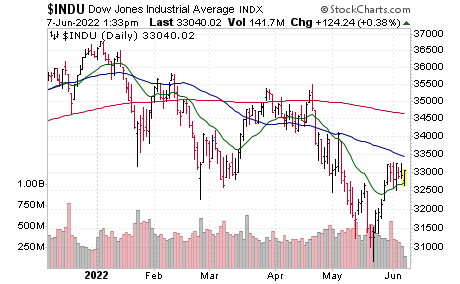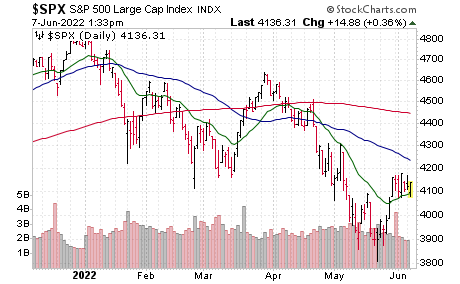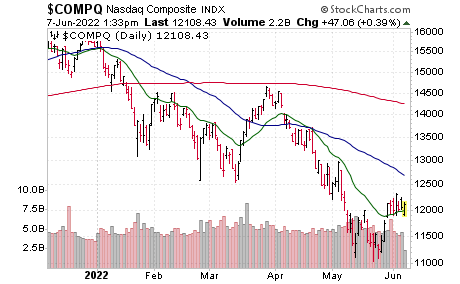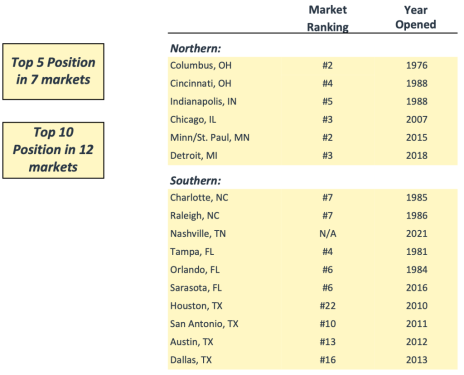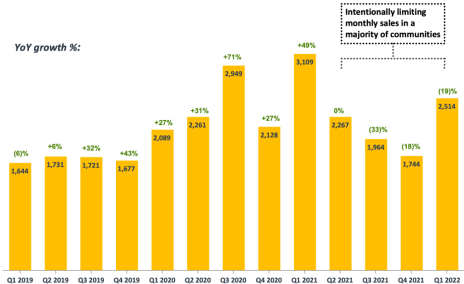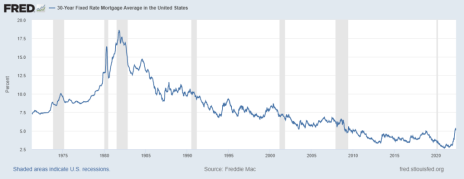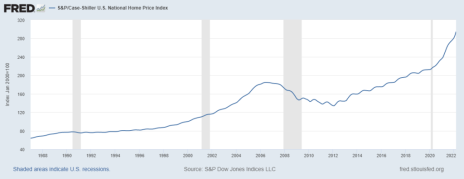Are you tired of turning on your television first thing in the morning and getting heartburn over the market’s gyrations?
Yeah, me, too. So, I’m swearing it off. I’m only going to peek at it a couple of times a day, since it doesn’t seem to be finishing the day as it starts, and I just don’t need the angst.
Instead, I’m going to keep looking at the macro-economic figures and try to do my very best to find the right investments for you to weather these ups and downs.
Cabot Stock of the Month Issue: June 9, 2022
Market Overview
Are you tired of turning on your television first thing in the morning and getting heartburn over the market’s gyrations?
Yeah, me too. So, I’m swearing it off. I’m only going to peek at it a couple of times a day, since it doesn’t seem to be finishing the day as it starts, and I just don’t need the angst.
Instead, I’m going to keep looking at the macro-economic figures and try to do my very best to find the right investments for you to weather these ups and downs.
Look, we are not in a recession. If you Google recession forecasts, you’ll get as many pros as you do cons. It’s not worth the worry. Unemployment, with a current rate of 3.6%, is incredibly healthy. Folks are still leaving their jobs for better ones.
The housing market—despite dire forecasts—is also robust. More listings are emerging, which will enable more buyers to actually close on homes.
Manufacturing and consumer sentiment continue to be healthy.
And most of all—from our investing perspective—some very expensive stocks are now becoming more buyable. And earnings are holding up well, with 77% of the S&P 500 companies reporting positive EPS surprises for Q1 2022.
Here at Cabot, we think the market is—at least for now—trending in the right direction. That could change tomorrow, and it probably doesn’t mean that we are going to be riding the bull anytime soon, but it looks like it’s improving.
Yet, because the markets are still very volatile, I’m sticking with a conservative strategy for my new picks, including the value-oriented stock I’m recommending this month.
Featured Recommendation
Focusing on Value: M/I Homes, Inc. (MHO)
So far this year, as you can see from the chart below—and amid the market’s roller coaster gyrations—Value stocks are suffering less than Growth stocks.
U.S. Equities - Russell Indexes
| Index | ETF | YTD | 1 Year | 3 Years |
| Large-Cap Value |
| -5.32% | -2.10% | 28.08% |
| Mid-Cap Value |
| -6.40% | -2.63% | 31.47% |
| Small-Cap Value |
| -7.31% | -9.67% | 31.15% |
| Large-Cap Growth |
| -22.03% | -7.20% | 56.46% |
| Small-Cap Growth |
| -23.80% | -24.80% | 16.15% |
| Mid-Cap Growth |
| -24.67% | -17.94% | 25.27% |
Source: Seekingalpha.com
Historically, when the markets get rough, investors tend to shy away from the high-flying growth stocks and lean into more conservative, value-oriented picks (more on that later). Consequently, I decided that our portfolio should also shift in that direction—to take advantage of lowering risk as well as scooping up bargains when great companies fall for no real, intrinsic reason.
Hence, this month’s pick: M/I Homes, Inc. (MHO). Now, I can understand if you’re scratching your head, thinking, “with home prices at historical highs, inflation and interest rates soaring, and a possible recession looming, why would you pick a homebuilder?” Well, I’m glad you asked. Because there are some very valid reasons why I chose this pick, courtesy of Bruce Kaser, Chief Investment Analyst of Cabot Undervalued Stocks Advisor and Cabot Turnaround Letter.
First of all, predictions of a recession are just hypotheses. I can find just as many folks who don’t believe we are headed for a recession as those who do. Mind you, I have no crystal ball, but so far, the economy—while definitely facing some challenges—is actually holding up pretty well. The brightest spot, of course, is low unemployment—which, all other things being equal, will help carry us through to the next peak, without a pointed tumble.
Next, the real estate industry is still very favorable. As you know, I own a real estate company, and I can tell you we have not slowed down one bit. But in my opinion, the even better news is that I’m seeing some price reductions which should help turn what has been an amazing sellers’ marketplace into a more evenly distributed arena where both buyers and sellers get a fair shot at achieving their housing goals.
And lastly, M/I Homes—as is the case with the majority of home-related businesses—is now trading on a deeply discounted basis. Bearing that in mind, I don’t expect these shares to take off immediately. But buying at this level will help ensure that we are purchasing the shares smartly and will reap the benefits when the economy shakes off its challenges and resumes a steady growth pace.
Let me tell you a little bit about M/I Homes.
- The company is ranked #13 on the Builder 100 list (builderonline.com)
- No fly-by-night, M/I has been in business since 1976 and public since 1983 (telling me the company knows who to weather economic ups and downs)
- M/I Homes has built more than 140,000 homes and operates in 16 markets
And since 2015, the company has been adding new markets in Minneapolis, Sarasota, Detroit and Nashville.
When I asked Bruce for a couple of his favorite portfolio holdings, M/I Homes was at the top of his list.
Here’s a closer look at Bruce’s most recent comments on the company:
“M/I Homes (MHO) is one of the country’s largest homebuilders, with operations in 15 states. The company’s shares have tumbled 36% from their 52-week high and now trade at their pre-pandemic price. Investors worry that the economy will continue to slow and possibly slide into a recession, while rising mortgage interest rates and sharply higher home prices threaten to further dampen demand. Also weighing on the shares are concerns over the higher costs of lumber, plastics and labor, as well as struggles with procuring supplies and labor. Investors are assuming that the dour outlook will become reality.
“While we appreciate the headwinds facing M/I Homes and its industry, we see a diversified, financially solid and well-managed company whose shares trade at a sizeable discount to their liquidation value.
“M/I Homes’ operations are diversified across home-price categories and states, and are located among the most valuable local communities, reflected in its #2 ranking in the highly regarded John Burns Submarket Desirability Index. While M/I Homes’ lower-priced offerings (about 42% of sales) expose it to price-sensitive buyers, about 58% of its sales are in less-price-sensitive categories in which buyers typically benefit from appreciation in their current homes when trading up. The company is more constrained by its ability to deliver homes than by any lack of demand.
“The company’s first-quarter revenue, profits and backlog set new record highs. The construction gross margin (the spread between sales price and construction and related costs) improved to an impressive 24.8%, comparable to its peers, while its overhead expenses were flat, helping boost profits by 8% compared to a year ago. The company continues to successfully pass along higher costs by raising prices. Return on equity was a healthy 22.6%. Backlog units rose 1% while backlog dollars rose 17%.
“We view the industry forecasts, which range from ‘strong growth for a decade’ to ‘sharp decline as the economy enters a recession’ with skepticism – the future is unknown. Our valuation thesis is based on a conservative outlook that includes a slowdown in industry demand and M/I Homes’ profits over the next few years. Our price target is based on only an incremental increase in the company’s P/TBV multiple to about .85x. We consider a multiple below 1x to be a discount. Historically, MHO shares rarely trade below .80x and the current 0.76x multiple was reached only once in the past decade – at the depths of the 2020 pandemic sell-off. The combination of healthy earnings and the modest boost in valuation drive the upside potential. Given the company’s low valuation, the current share price provides a considerable margin for safety if our thesis is wrong.
“Supporting the company is its strong balance sheet. Its $700 million in corporate debt bears interest at a very reasonable 4.5% average rate and doesn’t mature until at least 2028. Partly offsetting this debt is over $200 million in cash. M/I also originates mortgages for its customers, and the company maintains credit lines to finance these, but the mortgages are almost immediately resold and present essentially no risk to the company.
“As a homebuilder, M/I Homes needs to acquire properties for future development. In this regard, the company is well-positioned, owning 2.8 years of land inventory and controlling another 2.3 years through options. One side benefit: the company should benefit from rising inflation as these properties appreciate in value.
“We consider the company well-managed, based on its track record and strategy. We like that the current chairman and CEO, Robert Schottenstein, 69, is a member of the founding family and owns 2.4% of the shares. While the burn rate (stocks awarded to management as a percent of shares outstanding) is too high at 1.8% – we would consider 1% to be enough – we believe this rate will continue to taper, and our concerns are further assuaged by the recent step-up in share repurchases at below book value.
“With low investor expectations, strong current fundamentals and a reasonable likelihood for at least stable industry conditions over the next few years, M/I Homes shares have strong upside potential with relatively limited downside. BUY”
The shares of MHO are currently ranked #1 by analysts. The shares are priced around 46 right now, and Wall Street is forecasting a price target of 85.50. Earnings estimates are improving and estimated growth over the next five years is in the double digits. Yet, the shares are trading at a P/E of 3.42.
Now, that’s what I call a bargain!
M/I Homes, Inc. (MHO) 52-Week Low/High: $40.30 - 69.53 Shares Outstanding: 28.29 million https://www.mihomes.com | Why M/I Homes: Geographic Diversity Focus on Housing Affordability Strong balance sheet Undervalued |
About the Analyst: Bruce Kaser, Cabot Undervalued Stocks Advisor and Cabot Turnaround Letter
Bruce Kaser has more than 25 years of value investing experience in managing institutional portfolios, mutual funds and private client accounts. He has led three successful investment platform turnarounds, co-founded an investment management firm, and was principal of a $3 billion (AUM) employee-owned investment management company. Previously, he led the event-driven small/mid-cap strategy for Ironwood Investment Management and was Senior Portfolio Manager with RBC Global Asset Management, where he co-managed the $1 billion value/core equity platform for over a decade. He earned his MBA degree in finance and international business from the University of Chicago and earned a Bachelor of Science in finance, with honors, from Miami University (Ohio).
When I need a deep dive on value stocks, Bruce is our go-to at Cabot. With the markets in such turmoil, and value stocks currently outperforming growth, I asked Bruce to share his thoughts on the markets, as well as the sectors in which he is finding opportunities for his subscribers. Here’s our interview:
Nancy: I note that you have divided your Cabot Undervalued Stocks Advisor portfolio into two categories: Growth & Income Portfolio and Buy Low Opportunities Portfolio. And your Cabot Turnaround Letter stocks focus very heavily on value, too. Would you please expand on those definitions for my subscribers, and tell us what criteria, specifically, you are looking for in choosing stocks in each of these categories?
Bruce: Growth & Income Portfolio stocks are generally higher-quality, larger-cap companies that have fallen out of favor. They usually have some combination of attractive earnings growth and an above-average dividend yield. Risk levels tend to be relatively moderate, with reasonable debt levels and modest share valuations.
Buy Low Opportunities Portfolio stocks include a wide range of value opportunities. These stocks carry higher risk than our Growth & Income stocks, yet also offer more potential upside. This group may include stocks across the quality and market cap spectrum, including those with relatively high levels of debt and a less-clear earnings outlook. The stocks may not pay a dividend. In all cases, the shares will trade at meaningful discounts to our estimate of fair value.
The Cabot Turnaround Letter concentrates on out-of-favor stocks with real value. We focus intensely on the underlying value of the company, with a heavy emphasis on company fundamentals, including revenues and profits, free cash flow and the balance sheet, as well as the quality of management and the prospects for the company’s products and services. Usually these stocks have a catalyst, like new management, activist investor, spin-off transaction or other strategic level change that is likely to significantly improve the company’s prospects. These stocks generally have a greater risk/return profile than the Cabot Undervalued Stocks Advisor names.
Nancy: Although all style categories are down so far in 2022, Value stocks seem to be holding up better than Growth. Do you foresee that continuing to be the trend for the rest of the year?
Bruce: I see Value continuing to outperform Growth. About a year ago, value stocks started outperforming growth stocks, and this value-favorable difference has accelerated since year’s end. The added contribution from the higher dividend yields on value stocks has expanded this edge. Much of the vast performance edge that growth previously held over value during the past decade has evaporated. For small-cap stocks, value is now outperforming growth over the trailing ten years.
Investment trends don’t last forever, and hyper-growth tech stocks became irrationally overvalued as investors rode their upward momentum. At the same time, the market was ignoring many solid companies trading at reasonable valuations and dismissing the entire energy sector. With the abrupt change in inflation, monetary policy, energy prices and other factors, the market is coming to recognize the worthiness of value stocks while questioning the merits of many hyper-growth business models. Also, value companies generally have access to plenty of capital, whereas hyper-growth companies often need a steady flow of new capital which is no longer cheap or readily available.
Nancy: You have a few high-yield stocks in your portfolios. High-yield stocks often scare investors—especially in periods when earnings may become uncertain and dividends are cut or even eliminated. What fundamental criteria do you look for in evaluating that kind of risk in your higher-yielding selections?
Bruce: Yield by itself not a primary selection criterion. Our primary focus is on the undervaluation of the shares relative to the company’s fundamentals and prospects. We look at dividends as a bonus, an extra source of cash returns to help compensate investors for what might be a one or more year waiting period until the market returns its attention to the shares. In many cases, the higher yields are readily backed by solid cash flow, steady businesses and strong balance sheets; but not always. Sometimes, our stocks carry above-average dividends yields because investors have over-sold the stocks. To assess the dividend’s sustainability, we assess the company’s fundamental go-forward prospects, including revenues, profits, free cash flows and balance sheet condition, as well as management’s priorities. Unlike many investors, we mostly ignore the company’s dividend paying history, as future dividends are paid out of future cash flows not historical cash flows.
Nancy: How likely do you see a recession for the U.S. in 2022? And how do you think that might affect your portfolio choices?
Bruce: Our stock selection focuses about 90% on the company-specific situation, not a top-down view of the economy: we’re bottom-up as opposed to top-down. We are macro-aware, in that we want to understand the environment we are investing in. But, as Warren Buffett once said about stock forecasters which also applies to economic forecasters, “the only value of stock forecasters is to make fortune tellers look good.”
Nancy: What is your opinion about adding REITs to investors’ portfolios right now, as a conservative way to gain steady income? Which REIT sectors do you favor, and which would you stay away from? Why?
Bruce: We will recommend a specific REIT when the share valuation and company fundamentals make it compelling. We haven’t recommended any lately, as we are not seeing much in the way of attractive risk/reward trade-offs among REITS. The cheaper ones face weak revenue prospects and more expensive capital, while the stronger ones have ready access to capital even if they don’t need it, yet are generally too expensive for our strategy right now. Many office REITs are struggling and not attractive on their fundamentals even if their valuations may be interesting.
Nancy: I note that in a recent missive to your subscribers that you sold the shares of Marathon (MRO). Do you think energy company shares are at the over-valued point?
Bruce: We recommended Marathon Oil (MRO) to Cabot Turnaround Letter subscribers last September when energy stocks were seen as dirty, unwanted dinosaurs compared to hyper-growth tech stocks. Today, the world is seeing the value of these companies, particularly with oil trading at around $120/barrel. We were reluctant to sell Marathon, as the company’s cash-generating power remains incredibly strong. The shares are not expensive but are no longer the bargain they once were. Oil prices remain elevated toward the high end of reasonable, but their direction is unpredictable. Even though Russian oil may be cut off, we are well-aware of the ability and perhaps the new-found willingness of the Saudi government to open its oil taps just a bit.
The bane of being a contrarian and a value investor is that we sometimes sell too early. But we also recall the admonition of Baron Rothschild, the incredibly wealthy financier from a few centuries ago, who, when asked how he got so rich, replied, “I always sell too soon.”
Our Sell recommendation on Marathon was not a “sell it all today” call, but rather a recommendation to start trimming out. From a tactical perspective, investors holding MRO shares may want to initially reduce any outsized positions, then gradually chip away at the remaining balance over perhaps weeks. We see nothing wrong with keeping a stub position for an extended period. This both captures much of the strong profits but also allows some participation should the shares continue to ride higher.
From our initial recommendation in September 2021, the MRO investment has produced an estimated 160% total return.
Although energy companies are tied to oil and natural gas prices, companies can differ considerably in their operational and financial leverage to commodities, their management quality and priorities, and their financial conditions. Just because we have exited Marathon doesn’t mean we are turning bearish on all energy companies. We still have several recommendations in the sector.
Nancy: Are there any sectors or sub-sectors that you currently see as oversold?
Bruce: Many of the hyper-growth tech companies were never viable without outside funding, and today their funding is no longer cheap or easy. So, many aren’t worthwhile stocks until they can show they are real businesses that produce positive free cash flow. So, it’s hard to say that these are oversold.
Earlier, we mentioned that we don’t make economic forecasts. We will, however, take advantage of situations where others’ forecasts have produced exceptional investment opportunities. For example, investors worry about a recession, which has produced some compelling bargains in homebuilder stocks. Many trade below their liquidation value even as their assets (developed and undeveloped property) have solid value and the companies are generating strong profits and cash flow.
Nancy: What are the most critical challenges to the performance of the stocks in your portfolio right now?
Bruce: As most of our stocks are out of favor, investors may need to wait a while for their improving fundamentals to develop and shine through. This patience is generally the most difficult aspect of holding our stocks, yet also is what creates the opportunity, as most investors want quick returns now. Another challenge is that not every out-of-favor stock returns to favor, as their fundamentals may not improve as we have estimated. Sometimes the industry headwinds are too strong, other times the management doesn’t get the job done.
Portfolio and Industry Update
GitLab Inc. (GTLB) recently reported a great fiscal first quarter. The company posted revenue of $87.4 million, up 75% year over year, on a net loss per share of $0.18, considerably better than the $0.27 analysts had forecast.
Sid Sijbrandij, GitLab CEO and Co-Founder, noted that during the quarter, the company saw “a higher velocity of new customer wins, as well as seat expansion and tier upgrades of existing customers.”
Looking forward, GitLab is forecasting revenue of $93.5 - $94.5 million, with a net loss of $-0.24 to -$0.23. As a company in a high-growth stage, we don’t expect positive earnings anytime soon. But we are buying based on excellent growth metrics for future rewards
Our shares are holding up well. Continue to Buy.
Our investment in Invesco Dow Jones Industrial Average Dividend ETF (DJD) is holding steady, with a dividend yield of 3.19%. In these uncertain times, we love dividends! Continue to Buy.
| Stock of the Month Portfolio | ||||||||
| Company | Symbol | Date Bought | Price Bought | Price on 6/7/22 | Dividends YTD | Div Freq. | Gain/ Loss % | Rating |
| Archaea Energy Inc. | LFG | 2/11/22 | -- | -- | -- | -- | --% | Sold |
| iPath Series B Bloomberg Tin Subindex Total Return | JJT | 3/3/22 | -- | -- | -- | -- | --% | Sold |
| GitLab Inc. | GTLB | 4/13/22 | 49.02 | 49.35 | N/A | N/A | 0.68% | Buy |
| Invesco Dow Jones Industrial Average Dividend ETF | DJD | 5/13/22 | 44.41 | 45.91 | N/A | N/A | 3.39% | Buy |
| M/I Homes, Inc. | MHO | NEW | -- | 45.71 | -- | N/A | --% | Buy |
It’s important to lead with a couple of caveats:Value Investing and the State of the Real Estate Industry
Since I’m recommending a Value stock this month, I wanted to talk to you a little bit about Value Investing. The term simply means searching out companies whose shares are underpriced yet have strong fundamental underpinnings. It’s essentially the “buy low; sell high” investing strategy.
- Value is in the eye of the beholder. With the same information, two investors may estimate the value of a company very differently. Some consider only current earnings and assets, without taking growth into account. Others calculate forecast growth and the cash flow it will generate.
- Just because a company is cheaply priced doesn’t mean it’s undervalued. Many value investors concentrate on the price-equity ratio (P/E) a calculation of four quarters of the company’s earnings, divided by its current stock price, to determine valuation. But a low P/E does not tell the entire story. The stock may be trading cheaply because it’s a dog. Consequently, further analysis is required. But having said that, if you determine you have a good value candidate, make sure that it’s P/E is indeed low, compared to its industry and its five-year historical average P/E.
I start my Value analysis by searching for companies with low P/Es, in the bottom 10% of their peers. Next, I review the Price to Earnings Growth Ratio (PEG, or the P/E divided by the earning’s growth rate over the same period of time)—which should be less than 1. Debt should also be reasonable, at least as much as equity. And lastly, the share price should be less than tangible book value (tangible assets divided by total number of shares outstanding). Tangible assets are assets that you can physically see and touch, such as buildings, machinery, cash and inventory—not patents or goodwill, or other assets that cannot be liquidated for cash.
That’s a short and simple analysis, but there are much more elaborate models to determine value, too.
Certainly, as mentioned above, there are investors—even famous investors—who favor one strategy over another. But for the average investor, it’s essential to note that markets cycle up and down. Sometimes, growth stocks are the big winners, but in other instances (say, an economic downturn, or just a period of uncertainty), investors prefer value-oriented companies. And so far in 2022, Value stocks have held up the best.
Now, let’s take a look at the state of the current housing market.
While still boisterous, I am seeing some signs of a change in the market, as evidenced by existing home sales that fell 2.4% from the prior month, and pending homes sales that dropped 3.9%.
The Housing Affordability Index (HAI), as you can see below, has fallen to lows for the year. In the Index, a value of 100 means that a family with the median income has exactly enough income to qualify for a mortgage on a median-priced home. Above 100 means a family earning the median income has more than enough income to qualify for a mortgage loan on a median-priced home, with a 20% down payment.
Here’s an example: a composite HAI of 120.0 means a family earning the median family income has 120% of the income necessary to qualify for a conventional loan covering 80% of a median-priced, existing single-family home. An increase in the HAI, then, shows that this family is more able to afford the median-priced home.
Now, you can see from the graph that with the HAI above 100, this example family can still afford a home; it’s just a little more costly due to rising home prices.

Adding to the eroding affordability, is of course, rising mortgage rates. As of today, the average 30-year fixed mortgage rate is 5.83%—up from around 5% as of the end of April.
The following graph is of the Case-Shiller Home Price Index, as of May 31. You see that home prices have steadily risen since the last recession and look pretty steep. However, as I said earlier, I am now seeing significant reductions, and believe that looking at the index as of the end of June will reflect those decreases in home prices.
Zillow just reported a new forecast for U.S. home prices, estimating they would rise 14.9% between March 2022 and March 2023, down 2.9% from last month.
That, to me, seems overly optimistic. I tend to agree more with CoreLogic, who is predicting that home prices are set to decelerate to a 5% rate of growth.
Other forecasts include the Mortgage Bankers Association, estimating that home prices will rise 4.8% over the coming year, and Fannie Mae who says home prices will rise 11.2% this year, and 4.2% in 2023.
Noradarealestate.com says this: “Prices are rising due to a mismatch between supply and demand, but this is not a housing bubble. Many experts predicted that the pandemic would cause a housing crash on par with the Great Depression. That, however, is not going to happen. The market is in far better shape today than it was a decade ago. The housing industry has had a boom last year, with the largest annual gain in single-family house values and rentals, historically low foreclosure rates, and the highest number of home sales in 15 years.”
Who do you believe? Well, I’m right in the midst of the housing market, and I’m continuing to see robust sales, new listings coming to market, with prices moderating a bit. And with M/I Homes trading at such an undervalued level, I think this is a good entry point.
I’ll be sure to keep you updated as trends develop.
The next Cabot Money Club Stock of the Month issue will be published on July 14, 2021.
About the Analyst
Nancy Zambell
Nancy Zambell has spent 30 years educating and helping individual investors navigate the minefields of the financial industry. She has created and/or written numerous investment publications, including UnDiscovered Stocks, UnTapped Opportunities, and Nancy Zambell’s Buried Treasures under $10. Nancy has worked with MoneyShow.com for many years as an editor and interviewer for their on-site video studios.
As a lecturer and educator, Nancy has led seminars for individual investors at the National Association of Investors, Investment Expo and the Money Show. She has also taught finance, economics and banking at the college level, and has been quoted extensively in The Wall Street Journal, Investor’s Business Daily, USA Today, and BusinessWeek.
Nancy’s book, Make Money Buying & Selling Stocks is an introduction for new investors and a reminder for experienced investors on how to profit in the stock market.


